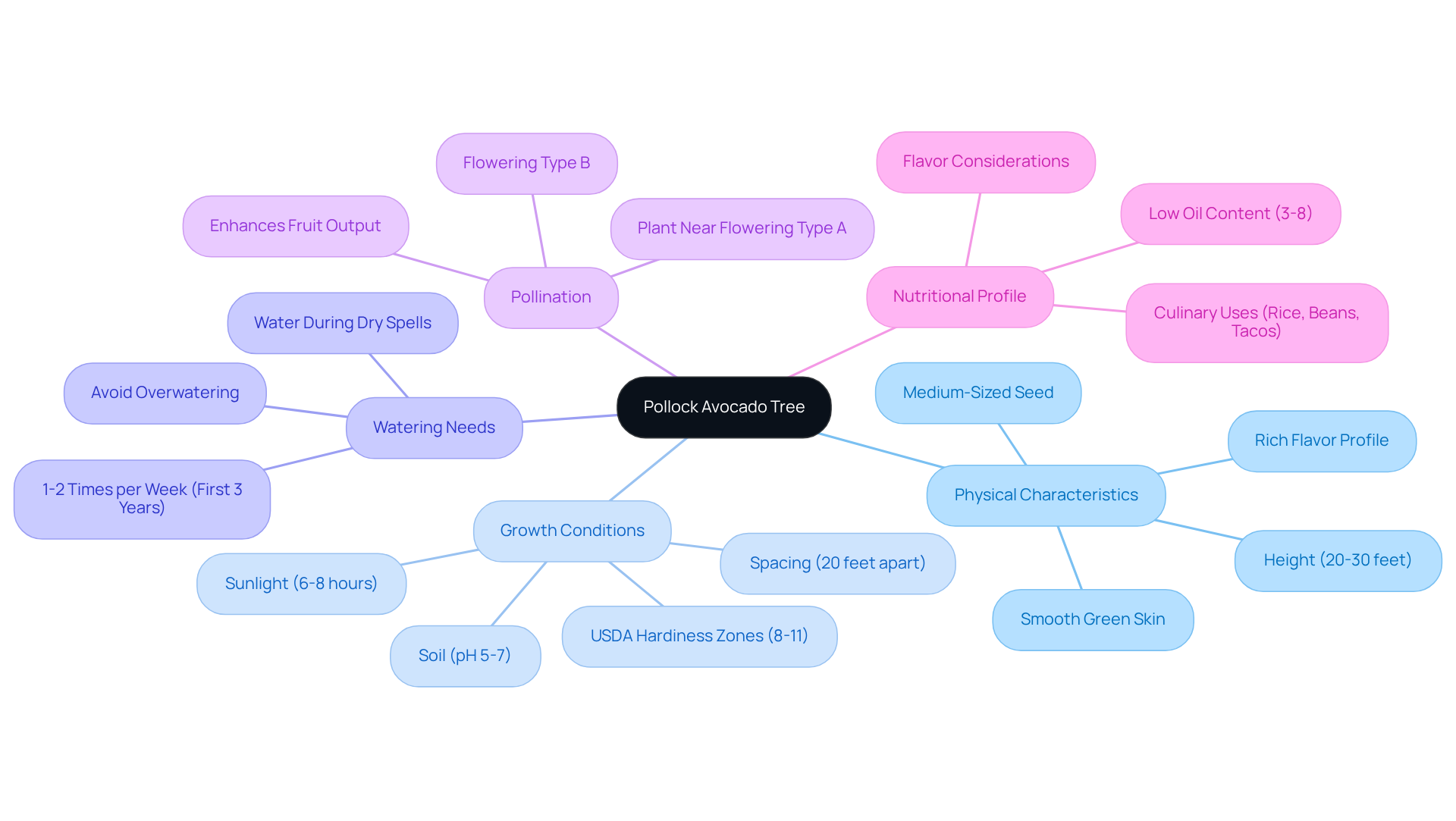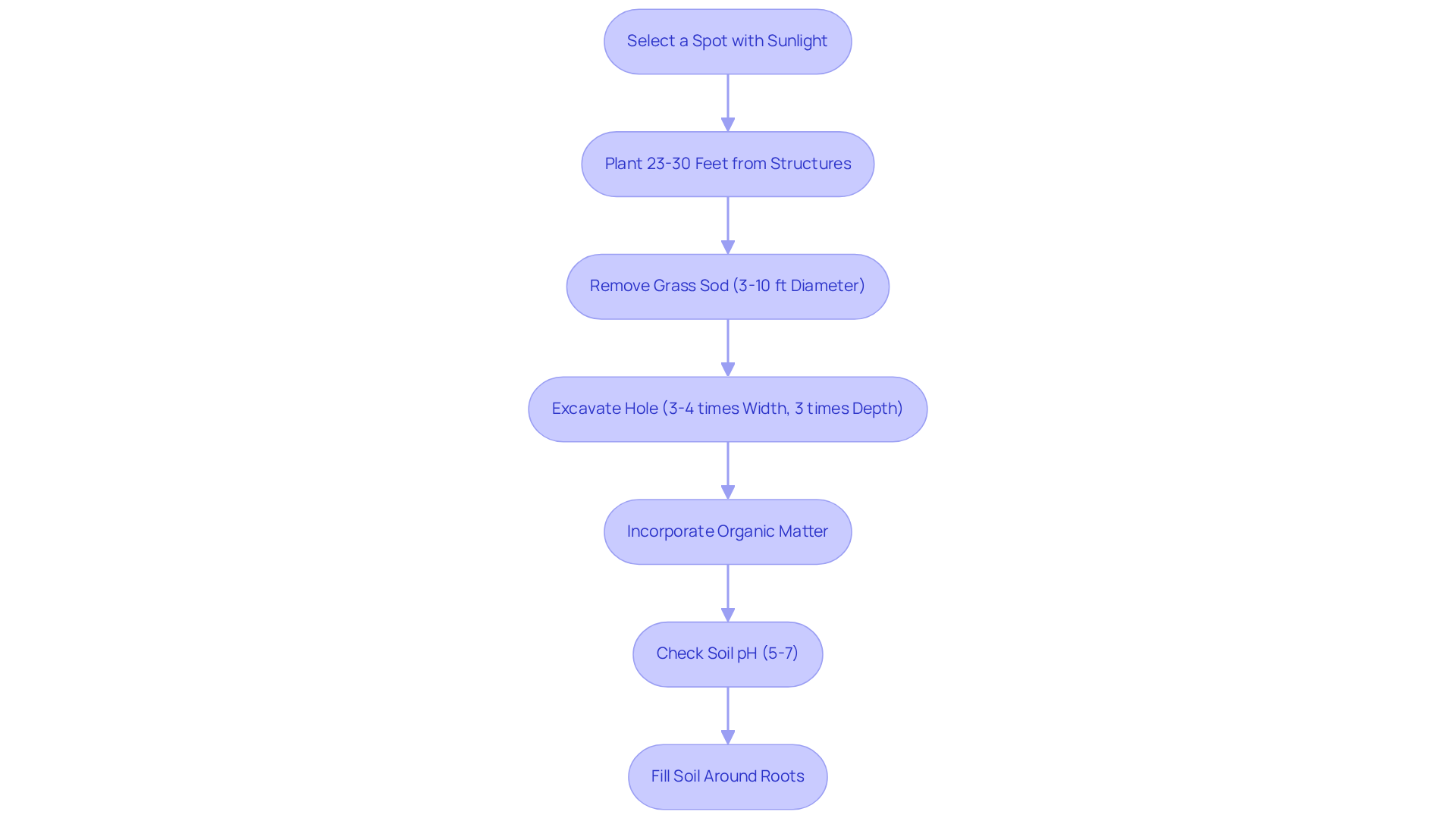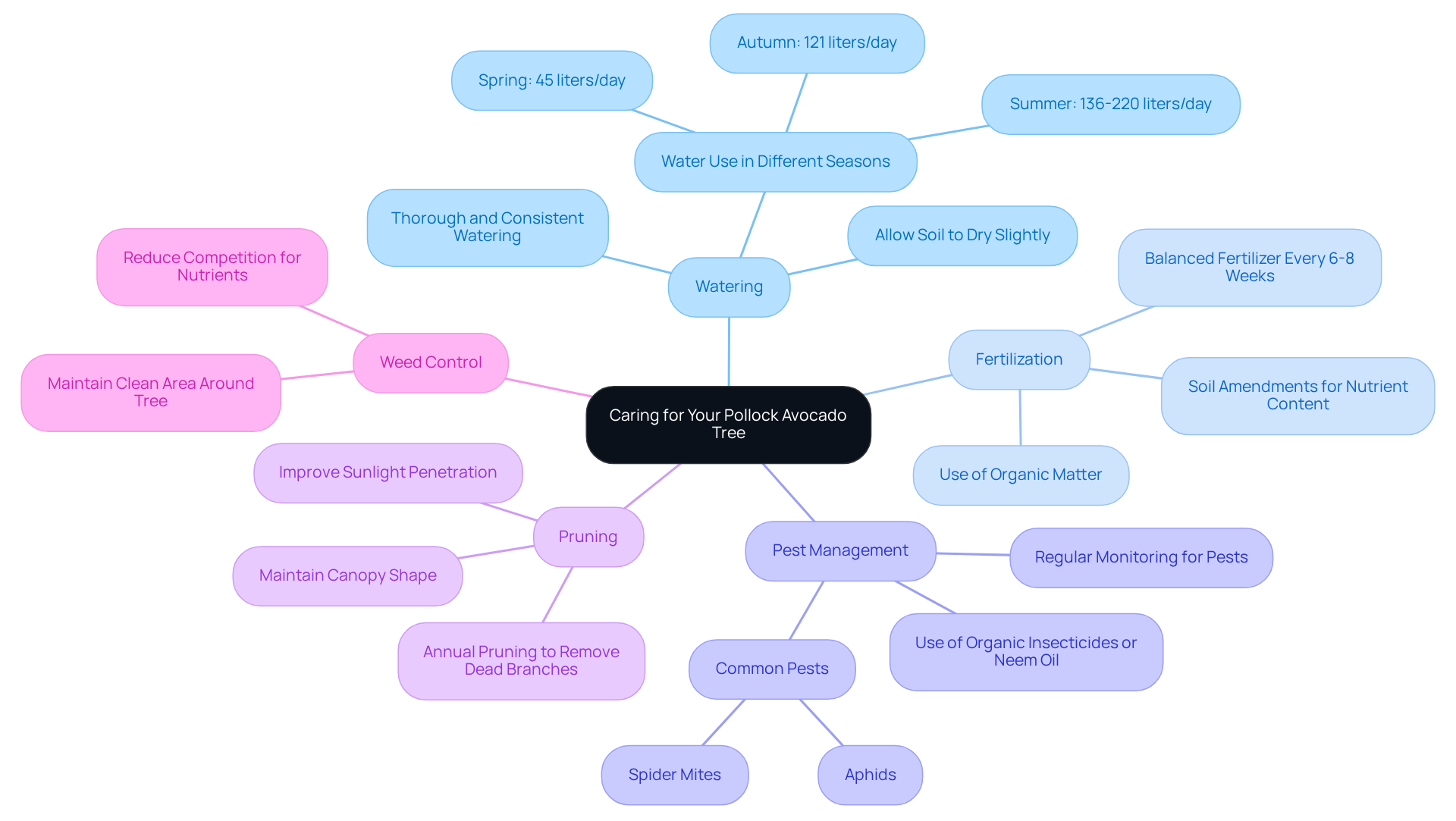
Grow Your Pollock Avocado Tree: Step-by-Step Planting Guide
Share
The Pollock avocado tree, recognized for its smooth skin and rich flavor, offers a unique opportunity for gardeners eager to cultivate a distinctive fruit. Successfully growing this West Indian variety necessitates a thorough understanding of its specific needs, including optimal sunlight exposure and soil conditions, which are crucial for ensuring a fruitful harvest.
With the abundance of information available, how can one effectively navigate the intricacies of planting and caring for this tree to achieve the best results?
Want to grow an avocado tree in your garden?
Explore Pollock Avocado Trees for sale at Everglades Farm - shipped directly from Florida.
Understand Pollock Avocado Tree Characteristics and Requirements
The Pollock avocado tree, a distinguished West Indian variety, is celebrated for its smooth, green skin and rich flavor profile. This plant typically reaches heights of 20 to 30 feet and thrives in full sun, requiring 6 to 8 hours of direct sunlight daily to ensure optimal growth. It flourishes in well-draining, sandy-loam soil with a pH range of 5 to 7, which is crucial for its health and productivity.
Regular watering is vital, particularly during dry spells, with a recommendation of 1 to 2 times per week for the first three years. However, caution must be exercised to prevent overwatering, as this can lead to root decay, a frequent problem for these plants. Furthermore, the pollock avocado tree benefits from being planted close to a Flowering Type A plant, which enhances pollination and fruit output, ultimately optimizing yield.
To promote growth in fruit-bearing plants, it is crucial to provide nutrients approximately 3 to 4 times annually after the first year. When planting multiple fruiting plants, ensure they are spaced at least 20 feet apart to prevent shading. This type of fruit has a low oil content of 3% to 8%, which may influence its culinary applications, rendering it less suitable for guacamole but outstanding for pairing with rice and beans or tacos.
This strategic planting approach is supported by case studies demonstrating improved fruit set when compatible varieties are grown in proximity. By following these increasing conditions and requirements, gardeners can successfully grow the unique fruit and savor its exceptional taste.

Select the Ideal Site and Prepare the Soil for Planting
Selecting the appropriate spot for your pollock avocado tree is essential for its success. Choose a location that receives ample sunlight and is shielded from strong winds, ensuring the plant can flourish. It is advisable to plant the sapling at least 23 to 30 feet away from structures and other plants to prevent shading and competition for nutrients.
Before planting, remove a 3 to 10 ft diameter ring of grass sod to prevent weed establishment, which can compete for nutrients. Prepare the ground by excavating a hole that is three to four times the width and three times as deep as the plant's container. This approach allows for adequate root expansion and access to nutrients. Enhance the soil by incorporating organic matter, such as compost, which improves drainage and enriches nutrient content.
The ideal ground pH for these plants varies from 5 to 7, so ensure the earth is well-draining and within this pH range. Fill the soil around the roots of the pollock avocado tree and tamp slightly to eliminate air pockets, which promotes healthy root growth and establishes the foundation for a thriving fruit-bearing plant.

Plant Your Pollock Avocado Tree Correctly
To successfully plant your Pollock avocado tree, follow these detailed steps:
-
Choose the Right Time: Ideally, plant your avocado plant between March and June to avoid sun damage during the hotter months. This timing is crucial for ensuring the plant's initial health and growth.
-
Prepare the soil for the Pollock avocado tree by ensuring the soil pH is between 6 and 6.5 for optimal growth. This slightly acidic range is essential for the plant's health, promoting nutrient absorption and root development.
-
Remove the Plant: Carefully take the plant from its container, ensuring minimal disturbance to the roots. This step is vital to prevent stress and promote a successful transition to the new environment.
-
Position the Plant: Place the plant in the center of the prepared hole, ensuring the top of the root ball is level with the surrounding earth. This placement is crucial for healthy growth, as it allows the roots to establish effectively in their new surroundings.
-
Backfill the Hole: Backfill the hole with modified earth, gently tamping it down to eliminate any air pockets that could hinder root development. This ensures that the roots are well-supported and can access moisture and nutrients.
-
Water Thoroughly: Water the plant thoroughly after planting to help settle the soil around the roots. Initially, water the plant 2-3 times a week, decreasing to once a week by the end of the first year. Consistent watering is key to establishing a strong root system.
-
Create a Moisture Retention Berm: Form a small berm around the base of the plant to retain moisture, ensuring consistent hydration as it acclimates. This simple technique can significantly enhance the plant's ability to thrive in its new environment.
-
Apply Coarse Mulch: Finally, apply approximately 1/3 cubic yard of coarse mulch around the base, keeping it several inches away from the trunk to prevent rot and promote healthy growth. This mulch helps retain moisture and suppresses soil pathogens, contributing to the overall health of the plant.
By following these steps, you can create an ideal setting for your fruit-bearing plant, establishing the conditions for a productive and flourishing specimen.

Maintain and Care for Your Pollock Avocado Tree
To effectively care for your Pollock avocado plant, consider the following essential tips:
-
Watering: Ensure the plant receives thorough and consistent watering, especially during dry spells. Allow the soil to dry slightly between waterings to promote healthy root development.
-
Fertilization: Feed your avocado plant with a balanced fertilizer specifically designed for fruit varieties every 6 to 8 weeks during the growing season. This practice encourages robust growth and increases fruit yield.
-
Pest Management: Regularly monitor your plant for pests, such as aphids and spider mites. If you notice any infestations, treat them promptly using organic insecticides or neem oil to protect your plant's health.
-
Pruning: Conduct annual pruning to remove dead or crossing branches. This not only helps shape the canopy but also improves sunlight penetration, which is vital for fruit production.
-
Weed Control: Maintain a clean area around the tree by removing weeds and debris. This reduces competition for essential nutrients and water, allowing your avocado plant to thrive.
By following these care tips, you can ensure your Pollock avocado tree remains healthy and productive.

Conclusion
The journey of cultivating a Pollock avocado tree necessitates an understanding of its unique characteristics and specific care requirements. By providing the right environment—ample sunlight, well-draining soil, and appropriate watering—gardeners can ensure the healthy growth of this remarkable fruit-bearing plant. The strategic planting and maintenance techniques outlined in this guide are essential steps for achieving a bountiful harvest.
Key insights include:
- The significance of selecting an ideal planting site
- Preparing the soil to meet necessary pH levels
- Implementing a consistent watering and fertilization schedule
Additionally, understanding the benefits of companion planting and effective pest management can enhance the overall health and productivity of the tree. Following these guidelines not only promotes the growth of the Pollock avocado but also enriches the gardening experience.
In essence, growing a Pollock avocado tree is a rewarding endeavor that requires attention to detail and a commitment to care. By embracing the outlined practices, gardeners can enjoy delicious fruit while contributing to a sustainable gardening ecosystem. Whether for personal enjoyment or culinary adventures, the Pollock avocado tree offers a flavorful addition to any garden.
Grow Your Own Delicious Pollock Avocado Today!
Start your gardening journey with Everglades Farm and enjoy fresh, homegrown fruit while enhancing your outdoor space.
Frequently Asked Questions
What are the main characteristics of the Pollock avocado tree?
The Pollock avocado tree is a West Indian variety known for its smooth, green skin and rich flavor profile. It typically reaches heights of 20 to 30 feet.
What are the sunlight requirements for the Pollock avocado tree?
The Pollock avocado tree thrives in full sun and requires 6 to 8 hours of direct sunlight daily for optimal growth.
What type of soil is best for growing a Pollock avocado tree?
The tree flourishes in well-draining, sandy-loam soil with a pH range of 5 to 7, which is crucial for its health and productivity.
How often should the Pollock avocado tree be watered?
Regular watering is vital, particularly during dry spells, with a recommendation of watering 1 to 2 times per week for the first three years.
What should be avoided when watering the Pollock avocado tree?
Overwatering should be avoided as it can lead to root decay, which is a frequent problem for these plants.
How does planting with Flowering Type A plants benefit the Pollock avocado tree?
Planting the Pollock avocado tree close to a Flowering Type A plant enhances pollination and fruit output, ultimately optimizing yield.
How often should nutrients be provided to promote growth in Pollock avocado trees?
Nutrients should be provided approximately 3 to 4 times annually after the first year to promote growth in fruit-bearing plants.
What is the recommended spacing when planting multiple Pollock avocado trees?
When planting multiple fruiting plants, they should be spaced at least 20 feet apart to prevent shading.
What is the oil content of the Pollock avocado fruit, and how does it affect its culinary uses?
The Pollock avocado fruit has a low oil content of 3% to 8%, which may influence its culinary applications, making it less suitable for guacamole but excellent for pairing with rice and beans or tacos.
Are there any studies supporting the planting of compatible varieties near the Pollock avocado tree?
Yes, case studies demonstrate improved fruit set when compatible varieties are grown in proximity, supporting the strategic planting approach.


